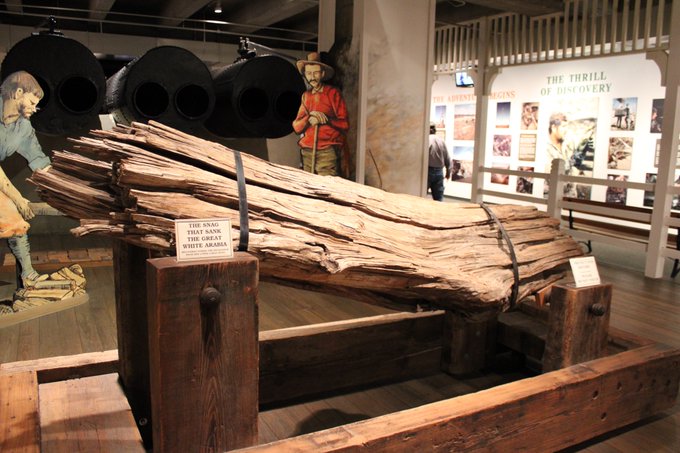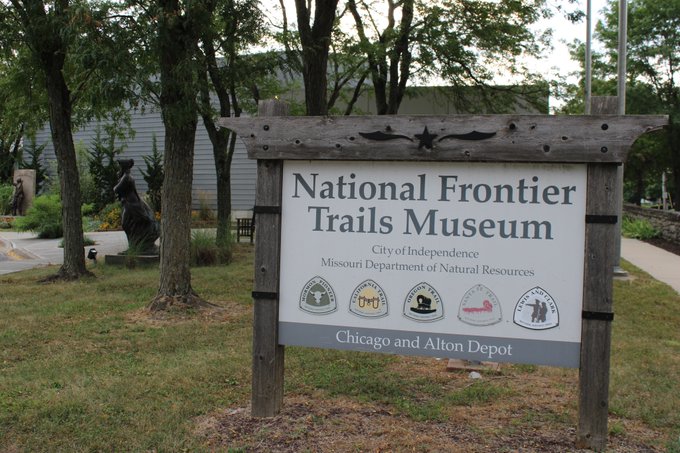December 20, 2022
Starting out from Independence, Missouri.
Ready to depart on the Oregon Trail?

In August 2021, this was the route my 11-year-old son followed (with the exception of a short trip up to St. Joseph, the other starting point for the Trail), on a road trip that took two weeks.

The county courthouse in Independence, Missouri – the central portion of which was built in 1836 – was the gathering point for wagon trains leaving along the Oregon Trail, which began in 1843.

Before setting out on the Trail, though, we’ll take a quick look around and learn a little about this part of Missouri. The most famous son of Independence, of course, was President Harry S. Truman.

Truman’s boyhood home in Independence, now a private residence.

And nearby, the childhood home of First Lady Bess Truman, who Harry says he fell in love with at age 7, and courted for several years until he returned home from World War I.

Clinton’s drugstore, right across the street from the courthouse, is where Harry Truman got his first job.

He worked at the soda counter and mopping floors.

Enjoying Harry Truman’s favorite ice cream sundae at Clinton’s Soda Fountain: chocolate with butterscotch sauce, topped with whipped cream and a cherry.

The other local specialty is Polly’s Pop, in a wide range of flavors.

This was Truman’s home after he was married. And which he used as his “Summer White House” from 1945 to 1953. Not exactly Mar-a-Lago. Sadly it was closed due to COVID, so we’ll have to come back someday to see inside.

The Truman Presidential Library was also closed due to COVID, which is a shame. I would have liked to get a “The Buck Stops Here” desk sign.

Independence is all about Harry Truman, but it has a more extensive history that one man. In 1831, the Mormon prophet Joseph Smith established a colony here, declaring it the original location of Garden of Eden. A Mormon Temple, which my son henceforth referred to as “the Mormon ice cream cone”, still towers over the town.

Tensions with non-Mormons quickly escalated, leading to the arrest and imprisonment of Joseph Smith by Missouri authorities here in the town of Liberty, a few miles north of Independence.

The town jail, where Smith was kept in a basement cell, has been reconstructed and preserved as a historic pilgrimage site for the faithful.

The Mormons were chased out of Missouri. After a sojourn in Illinois, where Smith was killed by a mob, they decided to emigrate west to Utah, along the wagon trail. We will meet them again on our journey.

A few blocks away from the old jail site in Liberty is the first bank that Jesse James and his gang robbed, on February 13, 1866.

Jesse James was born in this farm house outside of Kearney, Missouri, just north of Liberty, in 1847.

Missouri was a slave state, and the family owned slaves, who lived in shacks like this on the property. Jesse’s mother, in particular, was a fierce supporter of the Confederacy during the Civil War, in a state that was deeply divided in its loyalties.

The story is that young Jesse, age 15, was plowing this field when Union soldiers came and harassed his family. It nurtured a hatred of the Union in his breast, and he joined the guerrilla gang Quantrill’s Raiders, who waged a war of terror and murder against Union sympathizers.

After the war ended, Jesse and his comrades decided to continue the fight as outlaws. The bank in Liberty was owned by local Republicans who fought on the side of the Union, so it made (in their eyes) a legitimate target.

They entered the bank and stole $66,000 (the equivalent of $1.1 million today) from the vault. On making their getaway, they shot a 19-year-old bystander outside dead.

Jesse James died in 1882, at age 34, and we’ll see where and how when we reach St. Joseph. Originally he was buried in this plot on his family’s homestead.

Later his grave was moved to the local cemetery in nearby Kearney. After some looking, we were able to find it. He is buried next to his wife Zerelda, who was also his first cousin and shared the same name as his mother (!)

Chicken in a Sack, a very descriptive offering in Kearney, Missouri.

The story of the James boys brings us back to Independence. The county jail there, built in 1859, once held William Quantrill before the Civil War. After Jesse James was killed, his older brother Frank (a member of the gang) surrendered and was held here for 3 months before trial, where he was acquitted.

And now to our main story: Before Jesse James (much less Harry Truman) was even born, Independence was the starting point for three trails – to Oregon, California, and Santa Fe, New Mexico – because it was the farthest point westward on the Missouri River that could be reached reliably by steamboat.

The Steamboat Arabia Museum in downtown Kansas City displays artifacts recovered from just such a steamboat that snagged a branch and sank a bit further up the Missouri River in 1856.

The Arabia was lost under tons of mud and forgotten as the course of the river shifted, until a local family located and recovered it in 1988.

The wooden stern of the boat remained largely intact, including the rudder.


So were the boilers and steam engine that powered the boat’s massive paddle wheel.

Heck, they even found the rogue tree stump that sank that boat in the first place.

But the real treasure they discovered was the boat’s cargo: thousands of everyday items being shipped to the American frontier. Plates, bottles, metalware, hardware, tools, shoes and boots.


Clothing, almost perfectly preserved for over a century. Keys, door knobs, nails. All the commerce that connected the industrializing coast to the Western frontier.

Even 150 year old pickles still in their bottles.


Specialty items like a set of printer’s type for a frontier newspaper. Bottles of writing ink for letters back home …

Colorful buttons and beads for trade with the Indians. In short, everything you might stock up on when departing in your wagon on Trail west.

The amazing part is, these aren’t replicas. They’re actual items from the past, almost miraculously preserved. If not for the boat’s accident, these articles would have followed the trails west, with the emigrants.

Meanwhile, we’re following the Trail on its initial curve to the south, out of Independence.

The Trail passes right beside the Bingham-Waggoner mansion, built in 1852 by the owner of the local flour mill, and later purchased by a local artist famed for his images of the western frontier.

The flour mill itself now houses the National Frontier Trails Museum. Though it is temporarily closed due to COVID, the museum holds the largest archive of letters and diaries written by the emigrants along the Trail.

By wagon, the Oregon Trail took 5-6 months, making 10 or so miles a day. Obviously we can’t afford that pace, and our initial wagon ride will only take us the first few miles.

It’s worth noting that the wagons on the Oregon Trail were drawn either by oxen or mules, not by horses. We have mules today. Though these hybrids cannot reproduce, they combine the size and strength of horses with the stamina and canny intelligence of donkeys.

Some further miles south of Independence (and now in our car), we pass the Rice-Tremonti Home. Built in 1844, many emigrants reported receiving a warm welcome and fresh food there. The cabin to the right were the slave quarters, as Missouri was a slave state.

Cave Spring Park, a few miles further on, often served as the first day’s campsite. When we got there this morning, we were greeted with a summer thunderstorm, so we didn’t go venturing to see the spring itself.

But a few miles to the southeast, at the corner of 85th and Manchester, the grass-covered ruts of the Trail were just visible, making their way up this slope through the surrounding vegetation.

And soon, to the south of modern-day Kansas City, we reached the first river crossing, a relatively easy ford across the Blue River. From here, the wagon trains turned west, out of Missouri and into Kansas.

We ducked into Kansas to pay a visit to Joe’s BBQ/Gas Station, where the jars of BBQ sauce are stacked next to the bottles of 10W-40 motor oil at the checkout counter. And there’s a line right out the door.




BBQ sandwich at Joe’s in Kansas City, Kansas.

The modern metropolis of Kansas City, of 2.2 million people spanning two states, barely existed in the 1840s, except as a river landing. But we figured we’d explore it a bit, before heading any further on the Trail.




Kansas City is home to one of the 12 regional Federal Reserve Banks that help oversee and manage the U.S. economy.

It’s also home to the National World War I Museum.




A visit to the American Jazz Museum in Kansas City, Missouri.



And next door to it, the Negro Leagues Baseball Museum, telling the story of Black baseball stars in a segregated America.


The great Satchel Paige, whose career spanned five decades, starting in the Negro Leagues and ending as a Major League star.

Sitting on the baseball version of the Iron Throne of Westeros, at the Negro Leagues Baseball Museum in Kansas City, Missouri.

By this point, we were hungry enough want more Kansas City BBQ, so we paid a visit just down the street to Arthur Bryant’s, which has been in business since 1908.




All jacked up on Mountain Dew and Burnt Ends at Arthur Bryant’s BBQ, Kansas City, Missouri.

Heading out to the railway yards of North Kansas City, ready to strike out the next day towards St. Joseph, Missouri, the second historic starting point of the Oregon Trail.

Leave a Reply